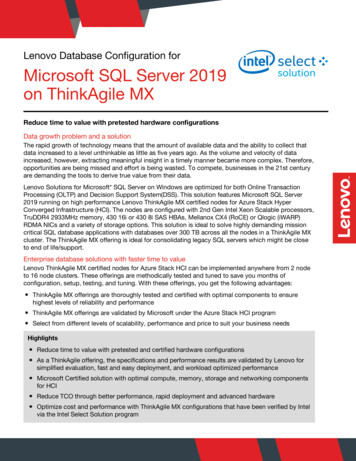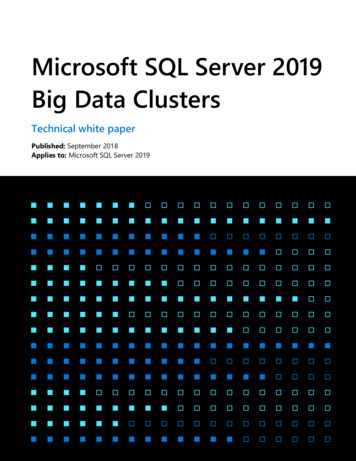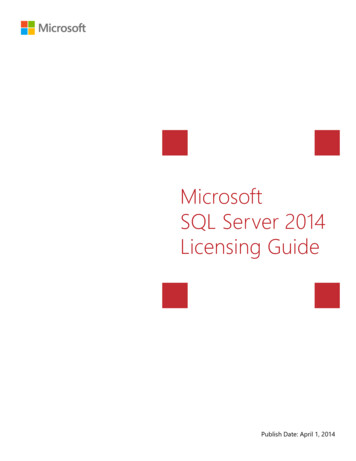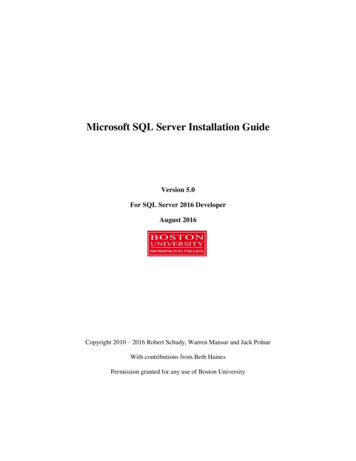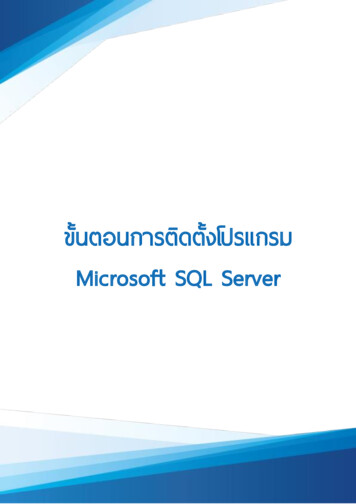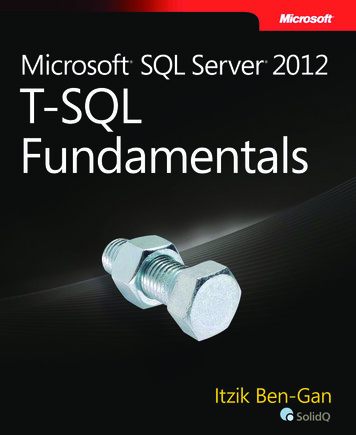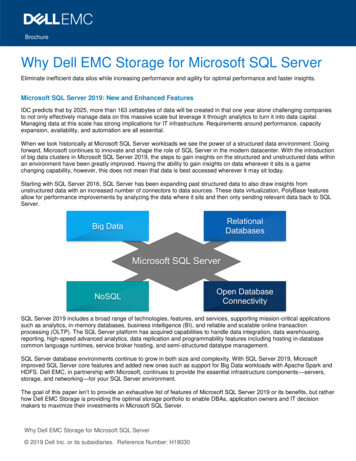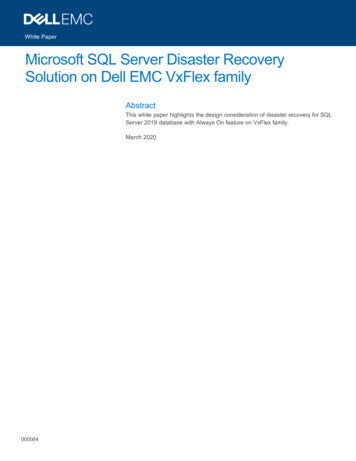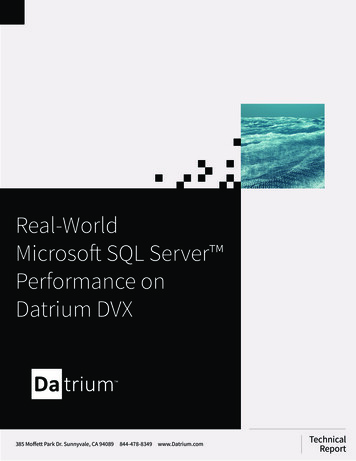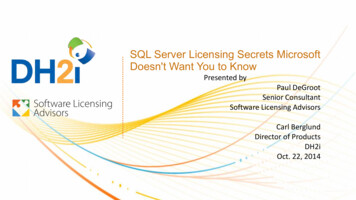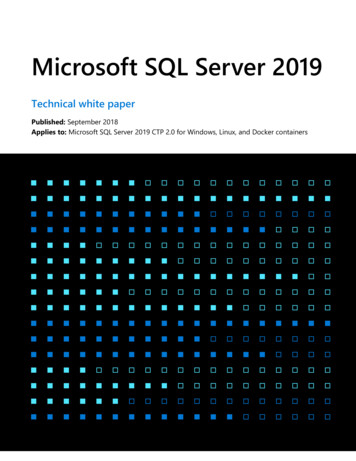
Transcription
Microsoft SQL Server 2019Technical white paperPublished: September 2018Applies to: Microsoft SQL Server 2019 CTP 2.0 for Windows, Linux, and Docker containers
CopyrightThe information contained in this document represents the current view of Microsoft Corporation on the issues discussed as of the date ofpublication. This content was developed prior to the product or service’ release and as such, we cannot guarantee that all details includedherein will be exactly as what is found in the shipping product. Because Microsoft must respond to changing market conditions, it should notbe interpreted to be a commitment on the part of Microsoft, and Microsoft cannot guarantee the accuracy of any information presented afterthe date of publication. The information represents the product or service at the time this document was shared and should be used forplanning purposes only.This white paper is for informational purposes only. MICROSOFT MAKES NO WARRANTIES, EXPRESS, IMPLIED, OR STATUTORY, AS TO THEINFORMATION IN THIS DOCUMENT.Complying with all applicable copyright laws is the responsibility of the user. Without limiting the rights under copyright, no part of thisdocument may be reproduced, stored in, or introduced into a retrieval system, or transmitted in any form or by any means (electronic,mechanical, photocopying, recording, or otherwise), or for any purpose, without the express written permission of Microsoft Corporation.Microsoft may have patents, patent applications, trademarks, copyrights, or other intellectual property rights covering subject matter in thisdocument. Except as expressly provided in any written license agreement from Microsoft, the furnishing of this document does not give youany license to these patents, trademarks, copyrights, or other intellectual property. Information subject to change at any time without priornotice.Microsoft, Active Directory, Azure, Bing, Excel, Power BI, SharePoint, Silverlight, SQL Server, Visual Studio, Windows, and Windows Server aretrademarks of the Microsoft group of companies.All other trademarks are property of their respective owners. 2018 Microsoft Corporation. All rights reserved.Microsoft SQL Server 2019 preview2
ContentsSummary . 4Industry landscape and trends . 4Data virtualization . 4Platform flexibility in the data estate . 5SQL Server 2019: power and flexibility . 6Enhanced PolyBase —query over any type of data . 7SQL Server Big Data Clusters —scalable compute and storage . 9Database engine enhancements .11Performance and scale .11High availability .11Security and compliance .12UTF-8 support .14SQL Server on Linux .14Containers .15Machine learning.15SQL Graph .15Intelligent database and query processing .16Troubleshooting and diagnostics .17Business Intelligence .18Reporting Services .18Power BI Report Server .18Analysis Services .19Enterprise Information Management .21SQL Server Integration Services .21Master Data Services .21SQL Server 2019 tooling .22Conclusion .23Calls to action .23Microsoft SQL Server 2019 preview3
SummaryMicrosoft SQL Server 2019 powers your organization by providing a data hub that you can use to accessstructured and unstructured data sources from across your entire data estate through a consistent interface. Therelational database engine scales to petabytes of data, and enhancements to PolyBase allow you to processdiverse big data and relational data sources using Transact-SQL from SQL Server.Building on SQL Server on Linux in Docker containers, Apache Spark and the Hadoop ecosystem, and the rapidlyforming industry consensus on Kubernetes as a container orchestrator, with SQL Server 2019 Big Data Clustersyou can deploy scalable clusters of SQL Server containers to read, write, and process big data from Transact-SQL,allowing you to easily combine your high-value relational data with high-volume big data with a single query.The SQL Server 2019 database engine supports an even wider choice of platform and programming language—including support for third-party language runtimes—and bringing SQL Server on Linux closer to feature paritywith SQL Server on Windows.SQL Server remains the only commercial database with AI built in, and now supports even more machine learningscenarios. SQL Server Machine Learning Services gives you the ability to do end to end machine learning in thedatabase without moving data. You can train the models using open source R or Python, and Microsoft’s scalablealgorithms. Once trained, making machine learning scripts and models operational is as simple as embeddingthem in Transact-SQL scripts. Any application connecting to SQL Server can take advantage of the predictions andintelligence from these models by simply calling a stored procedure.SQL Server 2019 builds on previous versions of SQL Server, which are industry leaders in performance andsecurity; SQL Server has been a leader in TPC-E and TPC-H benchmarks for the last five years, and the leastvulnerable database during the last eight years. It offers better performance than ever before, and new features tohelp manage data security and compliance.Please note: this document describes the features available in the first public preview of SQL Server 2019; CTP 2.0.More features will be added in later releases.Industry landscape and trendsData virtualizationRecognizing that different storage technologies are more appropriate for different types of data; a modernenterprise is likely to have data stored in a mixture of relational and non-relational data stores—often from severaldifferent vendors. A challenge for developers, data scientists, and business analysts is that to extract businessvalue from this data, they typically need to combine data from disparate sources; they typically do this by bringingall the relevant data from the source systems together on a single platform.In traditional business intelligence systems, copies of data are created and loaded into a reporting platform withextract-transform-load (ETL) processes; reporting and analysis is carried out on the copies. Whilst enablingenterprises to extract business value from their data, ETL processes have several common issues:Microsoft SQL Server 2019 preview4
Expensive to develop, maintain, and support—if they are to be repeatable and robust, ETL processes requireeffort to create, effort to keep them up to date, and effort to keep them running.Slow—ETL processes introduce an inherent delay. An IDC study1 found that more than 80% of data setsdelivered by ETL processes is between 2 and 7 days old by the time it reaches an analytical system. 75% ofbusinesses reported that delays in data processing had inhibited business opportunities.Must be secured—Each copy of a data set must be secured against unauthorized access, especially if the dataset contains personally identifying information (PII).Require storage—Each copy of a data set requires disk space to store—these costs grow if a data set is verylarge or is copied many times.An alternative to ETL is data virtualization. Data virtualization integrates data from disparate sources, locations andformats, without replicating or moving the data, to create a single "virtual" data layer that delivers unified dataservices to support multiple applications and users. The virtual data layer—sometimes referred to as a data hub ordata lake—allows users to query data from many sources through a consistent interface. Users’ access to sensitivedata sets can be controlled from a single location, and the delays inherent to ETL need not apply; data sets can beup to date.Figure 1: Data movement and data virtualizationPlatform flexibility in the data estateEnterprises want the flexibility to run best-in-class database software on any platform, as shown by the success ofSQL Server on Linux and SQL Server in Docker containers. SQL Server 2017 on Linux is Microsoft’s most successfulSQL Server product ever, with over seven million downloads since its release in October 2017. With the continuedrise of container orchestration systems like Kubernetes, database systems must be supported on the widest rangeof operating systems and virtualization platforms.13rd Platform Information Management Requirements Survey, IDC, October, 2016, n 502Microsoft SQL Server 2019 preview5
SQL Server 2019: power and flexibilitySQL Server 2019 builds on the industry-leading2 capabilities of SQL Server 2017, holding benchmarks in such areasas: Performance—SQL Server owns the top TPC-E3 performance benchmarks for transaction processing, the topTPC-H4 performance benchmarks for data warehousing—at 1,000 GB, 10,000 GB, and 30,000 GB—and the topperformance benchmarks with leading business applications.Security—According to the National Institute of Standards and Technology (NIST) public security board, SQLServer continues to have the lowest number of reported security vulnerabilities across the major databasevendors (NIST, 2010-2017).SQL Server 2019 continues the evolution of SQL Server, bringing new capabilities to the modern data ecosystemto better support and enhance data management and data-driven applications.Enhancements in SQL Server 2019 fall into five main
SQL Server 2019 builds on previous versions of SQL Server, which are industry leaders in performance and security; SQL Server has been a leader in TPC-E and TPC-H benchmarks for the last five years, and the least vulnerable database during the last eight years. It offers better performance than ever before, and new features to help manage data security and compliance. Please note: this .

